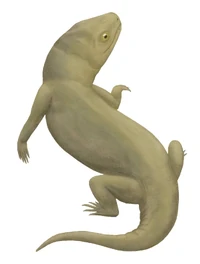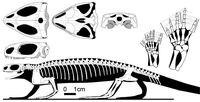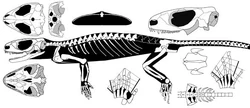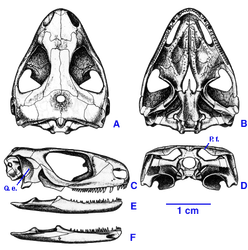
Ownetta kitchingourm, an Owenetta species.
Owenettidae is an extinct family of anapsids procolophonian parareptiles. Fossils have been found primarily from Africa and Madagascar, with one genus present from South America. It is the sister taxon to the family Procolophonidae. The family was constructed in 1939 for the type genus Owenetta. Since then several other genera have been assigned to Owenettidae, including Barasaurus and Saurodektes.

Barasaurus's skeleton. It was a owenettid reptile genus.
The oldest known owenettid, Owenetta rubidgei, dates back to the Wuchiapingian stage of the Late Permian. It and two other owenettids, Barasaurus and Saurodektes, have been found from the Beaufort Group in the Karoo Basin of South Africa. These strata span the Permo-Triassic boundary and provide evidence for the great faunal change that occurred as a result of the Permian–Triassic extinction event. Although most owenettids lived during the Permian, remains of some taxa such as "Owenetta" kitchingorum (soon to be placed within its own genus) extend the temporal range of the family into the Triassic. The youngest known owenettid is Candelaria from the Santa Maria Formation of Brazil, which lived during the Ladinian stage of the Middle Triassic. Owenettids were relatively small procolophonians that possessed broad heads and robust bodies. The family shares several synapomorphies that separate it from other related procolophonomorphs. The absence of an entepicondylar foramen is diagnostic to all members from which the humerus is known. In regards to cranial anatomy, there is no contact between the postorbital and parietal bones as a result of enlarged postfrontal bones, and the skull table is formed partly from large supratemporals lateral to the parietal bones.
Genus and Species[]
Owenetta[]
Owenetta is an extinct genus of basal procolophonian parareptile. Fossils have been found from the Beaufort Group in the Karoo Basin of South Africa. Although most procolophonians lived during the Triassic, Owenetta existed during the Wuchiapingian and Changhsingian stages of the Late Permian as well as the early Induan stage of the Early Triassic. It is the type genus of the family Owenettidae, and can be distinguished from other related taxa in that the posterior portion of the supratemporal bears a lateral notch and that the pineal foramen is surrounded by a depressed parietal surface on the skull table.
Species[]
The type species of Owenetta is O. rubidgei. It is known from several skulls, but no postcranial skeleton. It was described in 1939 from a partial skull found from the Late Permian Cistecephalus Assemblage Zone of the Beaufort Group. Several other localities, all from the overlying Dicynodon Assemblage Zone, have yielded the remainder of the known specimens. The naming of a new species in 2002, O. kitchingorum, extended the temporal range of Owenetta into the Early Triassic, meaning that the genus had survived past the Permian–Triassic extinction event. This new species was considered distinct from the type species based on features found from three nearly complete specimens that were present from the Lystrosaurus Assemblage Zone. Found in 1968, the first material of O. kitchingorum was a small block containing two skeletons in close proximity to one another (although at the time they were thought to be of the type species). These skeletons provided much of the information used to distinguish O. kitchingorum from the type species. O. kitchingorum differed from O. rubidgei in that it possessed small postparietals on the posterior edge of the skull table and that the maxilla held no more than 20 teeth, some of which were caniniform. The best preserved specimen seems to be a subadult individual on the basis of features of the skull table. A year after the new species of Owenetta was named, a paper proposed that it should be assigned to its own distinct genus, although a new name is yet to be provided. If this is the case, Owenetta is once again temporally restricted to the late Permian, and most likely died out at the end of the period as a result of the mass extinction event. Later that year the short limbed lizard Colubrifer campi, named in 1982 from a specimen found from the Early Triassic Lystrosaurus Assemblage Zone, was reassigned to the genus Owenetta. Based on a skull nearly identical to those known of Owenetta, it appears that the animal was almost certainly a procolophonian of that genus. This suggests that Owenetta did in fact survive the mass extinction event at the end of the Permian.
Phylogenetics[]
When Owenetta was first named and described, it and other procolophonians were thought to be within Cotylosauria, a group that comprised what was believed to be the most primitive of reptiles. Cotylosauria has since been renamed Captorhinida, which is now thought to be a paraphyletic group anapsids and anapsid relatives. Owenetta and other procolophonians are now known to be within the subclass Parareptilia. It has later been placed within the family Nyctiphruretidae, but is currently placed within the family Owenettidae, of which it is the type genus. The well preserved, nearly complete specimens of Owenetta can be helpful in phylogenetic analyses of procolophonians and the parareptiles, which have recently undergone many great revisions. Although the postcranial skeleton is only known from immature individuals, comparisons can be made with related taxa such as Barasaurus, which is known from both immature and mature specimens, that resolve this morphology issue. Owenetta has been used in some phylogenetic analyses to uphold the traditional theory that the procolophonians were the ancestors of turtles, although it now seems that turtles have evolved from parieasaurids, or even sauropterygians.
Gallery[]
Candelaria barbouri[]

Candelaria barbouri's skull.
Candelaria barbouri was the first procolomorph discovered in the geopark of Paleorrota, in the town of Candelária, by Llewellyn Ivor Price in 1946. It was about 40 centimetres (16 in) long and lived during the Ladinian in the Middle Triassic, about 235 million years ago.

